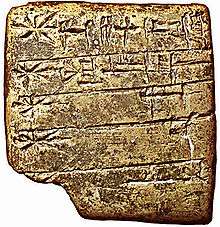Dingir
| Look up 𒀭 in Wiktionary, the free dictionary. |
Dingir (usually transliterated diĝir, pronounced /diŋir/) is a Sumerian word for "god." Its cuneiform sign is most commonly employed as the determinative for "deity" although it has related meanings as well. As a determinative, it is not pronounced, and is conventionally transliterated as a superscript "D" as in e.g. DInanna. Generically, dingir can be translated as "god" or "goddess".[1]
The sign in Sumerian cuneiform (DIĜIR, ![]() 𒀭)[2] by itself represents the Sumerian word an ("sky" or "heaven"),[3] the ideogram for An or the word diĝir ("god"), the supreme deity of the Sumerian pantheon. In Assyrian cuneiform, it (AN, DIĜIR,
𒀭)[2] by itself represents the Sumerian word an ("sky" or "heaven"),[3] the ideogram for An or the word diĝir ("god"), the supreme deity of the Sumerian pantheon. In Assyrian cuneiform, it (AN, DIĜIR, ![]() ) could be either an ideogram for "deity" (ilum) or a syllabogram for an, or ìl-. In Hittite orthography, the syllabic value of the sign was again an.
) could be either an ideogram for "deity" (ilum) or a syllabogram for an, or ìl-. In Hittite orthography, the syllabic value of the sign was again an.
The concept of "divinity" in Sumerian is closely associated with the heavens, as is evident from the fact that the cuneiform sign doubles as the ideogram for "sky", and that its original shape is the picture of a star. The original association of "divinity" is thus with "bright" or "shining" hierophanies in the sky. A possible loan relation of Sumerian dingir with Turkic Tengri "sky, sky god" has been suggested.[4]
Cuneiform sign

Sumerian

The Sumerian sign DIĜIR ![]() originated as a star-shaped ideogram indicating a god in general, or the Sumerian god An, the supreme father of the gods. Dingir also meant sky or heaven in contrast with ki which meant earth. Its emesal pronunciation was dimer.
originated as a star-shaped ideogram indicating a god in general, or the Sumerian god An, the supreme father of the gods. Dingir also meant sky or heaven in contrast with ki which meant earth. Its emesal pronunciation was dimer.
The plural of diĝir can be diĝir-diĝir, among others. ![]()
![]()
Assyrian
![]() The Assyrian sign DIĜIR could mean:
The Assyrian sign DIĜIR could mean:
- the Akkadian nominal stem il- meaning "god" or "goddess", derived acrophonically from the Semitic ʾil-
- the god Anum
- the Akkadian word šamû meaning "sky"
- the syllables an and il
- a preposition meaning "at" or "to"
- a determinative indicating that the following word is the name of a god
According to one interpretation, DINGIR could also refer to a priest or priestess although there are other Akkadian words ēnu and ēntu that are also translated priest and priestess. For example, nin-dingir (lady divine) meant a priestess who received foodstuffs at the temple of Enki in the city of Eridu.[5]
Digital encoding
The cuneiform sign is encoded in Unicode (as of version 5.0) under its name AN at U+1202D 𒀭.
See also
| Look up 𒀭 in Wiktionary, the free dictionary. |
- Religions of the Ancient Near East
- Mesopotamian mythology
- Sumerian language
- Akkadian language
- Hittite language
- Eblaite language
- Ishtar and Inanna two deities of the Mesopotamian Pantheon
Notes
- ↑ Edzard, 2003
- ↑ By assyriological convention, capitals identify a cuneiform sign, while the phonemic value of a sign in a given context is given in lower case. See also Sumerogram.
- ↑ Hayes, 2000
- ↑ Mircea Eliade, John C. Holt, Patterns in comparative religion, 1958, p. 94. The connection of dingir and Old Turkic tengere was made by F. Hommel in Grundriss der Geographie und Geschichte des alten Orients (1928). P. A. Barton in Semitic and Hamitic Origins (1934) suggested that the Mesopotamian sky god Anu may have been imported from Central Asia to Mesopotamia. The similarity of dingir and tengri was noted as early as 1862 (i.e. during the early phase of the decipherment of the Sumerian language, before even the term "Sumerian" had been coined to refer to it), by George Rawlinson in his The Five Great Monarchies of the Ancient Eastern World (p. 78).
- ↑ Margaret Whitney Green, Eridu in Sumerian Literature, PhD dissertation, University of Chicago (1975), p. 224.
References
Edzard, Dietz Otto (2003). Sumerian Grammar. Handbook of Oriental Studies. 71. Atlanta: Society of Biblical Literature. ISBN 1-58983-252-3.
Hayes, John L. (2000). A Manual of Sumerian Grammar and Texts. Aids and Research Tools in Ancient Near Eastern Studies (Second revised ed.). Malibu: Undena Publications. ISBN 0-89003-508-1.